| 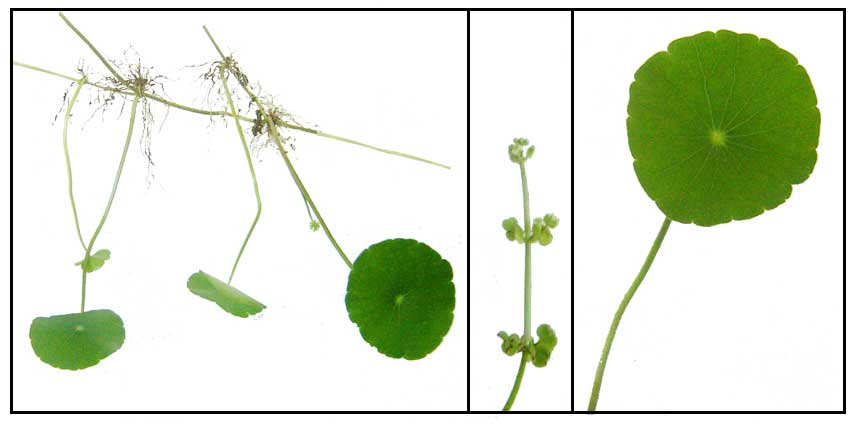
General
info
- Genus Hydrocotyle is an extensive family of almost
100 species of small, inconspicuous marsh herbs.
- The name "sheep
rot" came from a false belief that it causes the "liver rot"
when eaten by sheep; the real culprit proving to be liver fluke which
lives in the plant. It has more than a century of recorded folkloric
medicinal use.
- Etymology: The genus name Hydrocotyle derives from Greek words hydro, relating to water and cotyle, meaning 'small cup', referring to the growth environment and cup-like concave shape of the leaf blade. The specific epithet vulgaris derives from vulgo, meaning 'very common, banal, or ordinary due to widespread use'. (22)
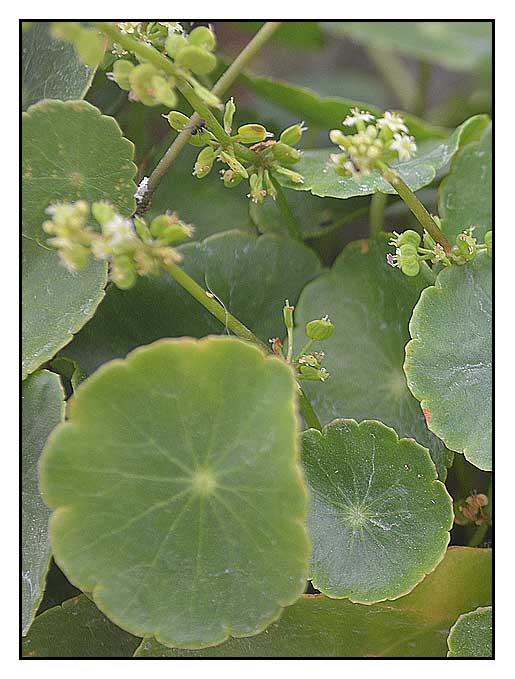 Botany Botany
• Pennyworth is a creeping or floating perennial herb. Stems are slender,
creeping, rooting at the nodes. Leaf stalk is attached to the leaf blade
in the center of the under-surface. Leaves have long and slender petioles,
glossy, dark green, crenate, peltate to orbicular, 6 to 9 veined, up to
4 cm across. Flowers are white, tinged with pink to purplish green, 1 millimeter, subsessile,
3 to 6 in a simple head-like umbel, 3 millimeters across, sometimes with 1 to 3 whorls
of flowers below.
• A small creeping aquatic, herbaceous perennial plant with umbrella-like leaf, common in wet places such as wetlands, marshes and swamps, sometimes even in deeper water. It only reaches stature heights of 5 to 20 centimeters. Plant forms numerous, up to 1 meter long, creeping offshoots. Leaves are green, shiny, waxy, serrated, rounded, shield-shaped leaves, with radially extending veins, diameter of up to 4 centimeters, but are often smaller. Long hairy petiole is located in the middle of the leaf underside. Tiny, inconspicuous, hermaphrodite flowers are in low-flowered inflorescences or whorls, with the stems of the inflorescence about half as long as those of the leaves. Petals are greenish, white or reddish. Fruits are flat, warty and winged. (20
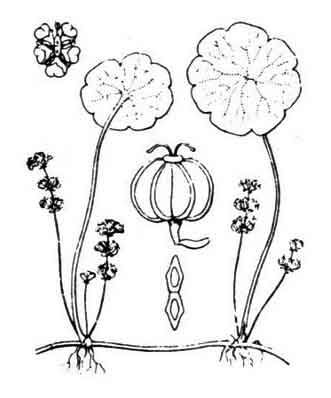 Distribution Distribution
- Recently introduced to the Philippines.
- Grows well in marshy and acidic soil.
- Provides good ground cover.
- Propagated by cuttings and seeds.
- Native to Albania, Austria, Azores, Baltic States, Belarus, Belgium, Corse, Czechoslovakia, Denmark, France, Germany, Great Britain, Greece, Hungary, Iceland, Ireland, Italy, Lebanon-Syria, Morocco, Netherlands, Norway, Palestine, Poland, Portugal, Sardegna, Sicilia, Spain, Sweden, Switzerland, Turkey, Ukraine, Yugoslavia.
- Despite its plentiful distribution, it is classified as critically endangered in Croatia, vulnerable in Switzerland, and near threated in Norway. In France, it is protected by regional legislation.
(15)
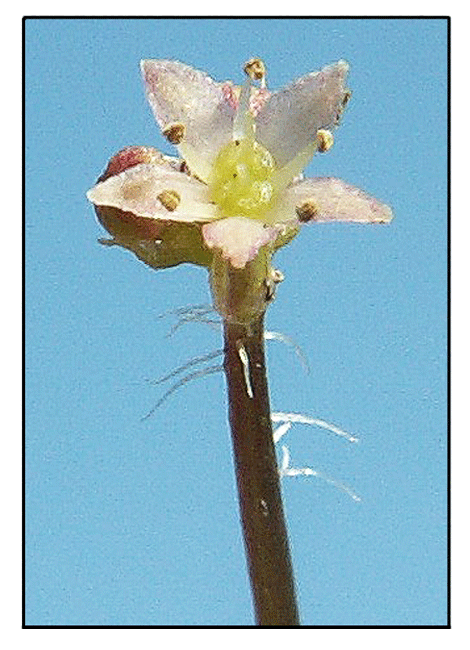 Constituents Constituents
• Study isolated an amorphous saponin designated as hydrocotyle-saponin B. (6)
• GC-MS analysis of stem, flowers and leaves (S, F, L) for essential oil yielded
15 components viz., hexenal, (2E)-hexenal, 3-hexen-1-ol, santalene, ß-farnesene, ß cubebene, y-muurolene, ß-bisabolene, y-sesquiphellandrene, nerolidol, caryophyllene oxide, ledol, Z-α-bisabolene epoxide, glubulol, epi-globulool, 5,5-dimethyl-4-(3-methyl-1,3,butadienyl)-1-oxapirol[2.5]octane. (see study below) (10)
• Study for secondary metabolites yielded flavonoids, reducing sugar, saponins, steroids, tannins, and terpenoids. No alkaloids, anthraquinones, and cyanogenic glycosides were detected. (11)
• Vitamin analysis yielded ß-carotene 10.4 mg/kg, riboflavin 4.08 mg/kg, vitamin C 70.2 mg/kg, and vitamin E 26.9 mg/kg, with non irritating pH levels of 5.7 and 7.14 for 50% and 75% extract concentrations. (see study below) (12)
- Phytoconstituent study yielded sterols ++ triterpenes +, flavonoids +++, alkaloids +++, saponins ++, glycosides +, tannins +. (see study below) (12)
Properties
- Considered vulnerary.
- Studies have shown cytotoxic, phytoremediative, waste water purifying, antimicrobial, antioxidant, radical scavenging, biofilm formation inhibitory, diuretic properties.
Parts utilized
Leaves and roots.
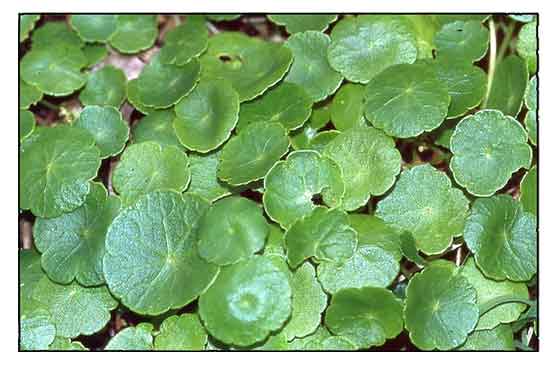 Uses Uses
Edibility
- Leaves are cooked; eaten in limited
amounts. Has a strong carrot taste,
Folkloric
- In Samar, used for diarrhea.
- Subanens of Zamboanga del Sur use decoction of whole plants for cough and kidney stones. (9)
- In the Ilongot-Egongot community of Maria Aurora, Aurora, Philippines, fresh leaves are taken orally for treatment of abdominal pain, cough, kidney disease, high blood pressure, cancer, and as antioxidant and immunostimulant. (13)
- Agusan Manobo in Agusan del Sur use leaves, eaten fresh or drunk as decoction, for diabetes, fever, and hypertension. Sap of leaves or poultice of leaves applied to cuts or wounds. (19)
- Elsewhere has a long recorded history of folkloric medicinal use.
- In 1850s, used in India
for treatment of leprosy.
- Used for eczema and other dermatologic maladies such as scrofula, ulcers.
- Also used for rheumatism, headaches, dizziness, bloody stools.
- Leaves used to dress burns or applied to skin diseases.
- In Malaya, traditionally used for treating wounds and as a diuretic.
- In Danish folk medicine,
used for whooping cough.
Others
- Suggested infusion use: 1 ounce of root in 1 pint of fluid, used as
1/2 - 1 fluid ounce 3 - 4 times daily.
Studies
• Cytotoxicity / Human Erythromyeloblastoid Leukemia Cells /Stem and Roots: Study showed cytotoxic activity of compounds (C1 and L1) isolated from the stem and root of H vulgaris. L1 was deduced to be panaxynol. C1 and L1 were cytotoxic toward human erythromyeloblastoid leukemia cells, K-562 with IC50 of 13.9 µM and 34.2 µM, respectively, using MTT cell viability assay. (2)
• Waste Water Purifying Effect: Study was done to evaluate the removal effects of H. vulgaris on CODCr, nitrogen and phosphorus in municipal domestic wastewater. Results indicated H. vulgaris was adaptable to grow in municipal domestic waste water with good purifying effect and is recommended as a specific aquatic vegetation in phytoremediation of municipal waste water. (3) Study evaluated the treatment effect of H. vulgaris as a floating bed plant on aquaculture waste water. Simulated eutrophic water with different concentration gradients was arranged in pond water, and Hydrocotyle vulgaris was cultivated for 49 days with the ecological floating bed as the carrier. Results showed removal rates of TN, TP, and NH4+-N of the simulated eutrophic water from different polluted loads reached more than 91%, 96%, and 50% respectively. H. vulgaris showed good purification effect on aquaculture wastewater. (17)
• Phytoremediation Potential for Textile Dye: Study evaluated the potential of H. vulgaris as an aquatic plant for phytoremediation of C.I. Basic Red 46. Overall, the increase in activity of antioxidant enzymes was much higher in the roots than in the leaves. No significant increase in malondialdehyde (MDA) content was detected in both roots and leaves suggesting high efficiency of the antioxidant system in the elimination of reactive oxygen species. (7)
• Essential Oil / Antimicrobial Activity / Cytotoxicity: Study of leaves, stems, and flowers for essential oil yielded 16 components. The essential oil was evaluated for antimicrobial activity on E. coli, P. aeruginosa, S. aureus, F- oxysporum and for cytotoxicity on RD, Hep-G2, LU cancer cells. The essential oil of H. vulgaris had weaker bioactivity than H. bonariensis. (see constituents above) (10)
• Free Radical Scavenging / Antioxidants /
Biocosmetic Antidote for Aging: Study the free radical scavenging activity, antioxidants, and physiological properties of H. vulgaris which could serve as basis for development of a biocosmetic antidote for pathological aging. Results showed H. vulgaris has abundant flavonoids and alkaloids with trace amounts of tannin. It has good scavenging activity for free radicals with IC50 of 29.75 and antioxidant activity of 158.13 (total phenolics as gallic acid in % w/w). (see constituents above) (12)
• High Invasion Risk: The growth habit, morphological and reproductive characteristics of H. vulgaris were systematically evaluated to assess its invasion risks. Study reports on its adaptability and phenotypic plasticity, wider ecological tolerance, aggressive high density occupancy, extremely high reproductive speed (50 times a year by vegetative and seed propagation). Invasion risk index assessment indicated H. vulgaris has a very high risk of invasion with a score of 71, suggesting it to be an extremely dangerous and forbidden species to be introduced, with risks to community species diversity. Suggestions were made on invasion risk management. (16)
• Quorum Sensing Inhibition Activity against Biofilm Formation Inhibition: Study evaluated the extracts of 16 Ilongot-Egongot ethnobotanicals for QS inhibition activity against biofilm formation in Pseudomonas aeruginosa clinical isolate and Pseudomonas aeruginosa PNCM 1335. Hydrocotyle vulgaris showed decreased in biofilm formation, exhibiting downregulation of lasR in both test bacteria. (18)
• Diuretic: Study evaluated the diuretic activity of a methanolic extract of Hydrocotyle vulgaris in albino mice using extract doses of 20 and 40 mg/kg. Furosemide was used as reference drug. The methanol extract increased the urine volume and electrolyte balance in a dose dependent manner similar to furosemide. (21)
Availability
Wild-crafted. |

![]()

